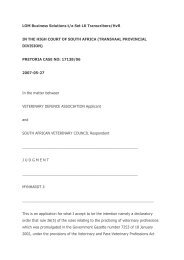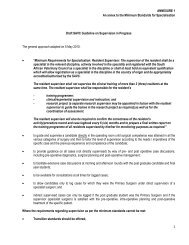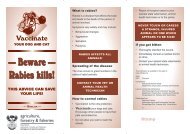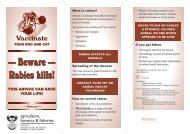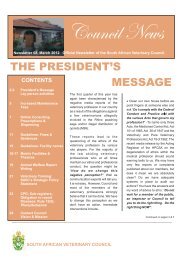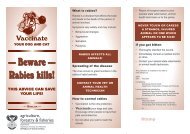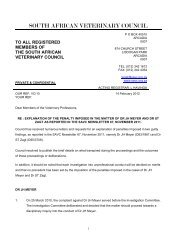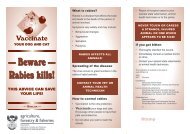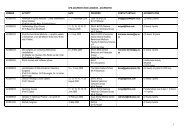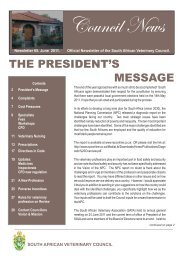Rabies Guide 2010.pdf - the South African Veterinary Council
Rabies Guide 2010.pdf - the South African Veterinary Council
Rabies Guide 2010.pdf - the South African Veterinary Council
Create successful ePaper yourself
Turn your PDF publications into a flip-book with our unique Google optimized e-Paper software.
RABIES CONTROL STRATEGIES<br />
56<br />
It is beyond <strong>the</strong> scope of this publication to provide<br />
details of appropriate rabies control principles and<br />
strategies for all circumstances and geographic areas in<br />
<strong>South</strong> Africa. The following general principles should,<br />
however, always be considered and adapted when<br />
controlling a specific outbreak. Control strategies<br />
include quarantine, confirmation of diagnosis,<br />
determining <strong>the</strong> origin and spread of an outbreak,<br />
and specific measures to terminate transmission.<br />
The property on which <strong>the</strong> disease has presumably<br />
occurred, should immediately be placed under<br />
quarantine. This may be done by serving a quarantine<br />
notice on an individual person or, if a large area is<br />
involved, by means of a notice in <strong>the</strong> Government<br />
Gazette or printed media.<br />
It is absolutely essential to confirm <strong>the</strong> diagnosis of<br />
rabies. Good-quality specimens must be collected.<br />
The investigating officer must submit full details of<br />
all contact animals, <strong>the</strong> date of contact and animals’<br />
vaccination status.<br />
In <strong>the</strong> case of dogs and cats, full particulars of rabies<br />
vaccination, including <strong>the</strong> vaccination dates, type of<br />
vaccine, batch number and name of <strong>the</strong> vaccinating<br />
officer must be determined. Human contacts must<br />
be reported and referred to <strong>the</strong> relevant local health<br />
authority.<br />
It is important to determine <strong>the</strong> possible origin<br />
of <strong>the</strong> rabies outbreak by checking whe<strong>the</strong>r any<br />
wild carnivores, mongooses or stray cats and dogs<br />
have recently been noticed in <strong>the</strong> area. In addition<br />
<strong>the</strong> investigating officer should establish whe<strong>the</strong>r<br />
animals were attacked and obtain a full history<br />
of any bite wounds inflicted. An investigation to<br />
determine whe<strong>the</strong>r any o<strong>the</strong>r animals in <strong>the</strong> area or<br />
on neighbouring farms were bitten or had contact<br />
with <strong>the</strong> suspicious vector should be performed.<br />
All neighbours of infected farms must be notified<br />
about <strong>the</strong> disease so that <strong>the</strong>y can prevent it spreading<br />
to <strong>the</strong>ir livestock. It is always a good idea to notify<br />
<strong>the</strong> local farmers’ association or even <strong>the</strong> district<br />
agricultural union of outbreaks. In this way, inhabitants<br />
of <strong>the</strong> entire area are alerted to <strong>the</strong> outbreak. This can<br />
also promote <strong>the</strong> state veterinary services’ surveillance<br />
efforts. In urban areas <strong>the</strong> community is generally<br />
notified through newspapers, radio and television.<br />
When an outbreak has been confirmed, <strong>the</strong> responsible<br />
state veterinarian decides on <strong>the</strong> area requiring<br />
vaccination. The general rule for urban outbreaks<br />
caused by <strong>the</strong> mongoose strain, is to vaccinate all<br />
dogs and cats in <strong>the</strong> affected street and neighbouring<br />
blocks. With farm outbreaks, animals on <strong>the</strong> infected<br />
property should be vaccinated. With outbreaks on<br />
small holdings it is important to vaccinate animals on<br />
surrounding properties.<br />
If <strong>the</strong> outbreak is confirmed as <strong>the</strong> result of a canid<br />
strain of rabies virus, <strong>the</strong> objective must be to<br />
vaccinate all dogs and cats within <strong>the</strong> immediate<br />
surrounding area up to a radius of approximately 25<br />
km, at <strong>the</strong> discretion of <strong>the</strong> state veterinarian.<br />
Large-scale vaccination<br />
This approach is <strong>the</strong> initial response to rabies<br />
outbreaks in endemic high-risk areas. The aim should<br />
be to vaccinate at least 70% of <strong>the</strong> animal population<br />
at risk in a single campaign within as short a period as<br />
possible. Where this cannot be achieved, two or more<br />
campaigns should be conducted within a year.<br />
Cordon vaccination<br />
The aim of cordon vaccination is to create a barrier<br />
of animal immunity. This approach has become<br />
increasingly important during <strong>the</strong> second phase of<br />
canine rabies elimination, particularly in <strong>the</strong> vicinity<br />
of international borders and national as well as<br />
provincial game reserves. This is necessary to prevent<br />
reinfection of areas currently free from rabies and to<br />
protect rabies-free wildlife areas. A cordon of 20 to 30<br />
km is usually sufficient for this purpose.<br />
Ring vaccination<br />
The long-distance transport of animals, particularly<br />
dogs that may be incubating <strong>the</strong> disease, is of<br />
increasing concern to veterinary authorities attempting



